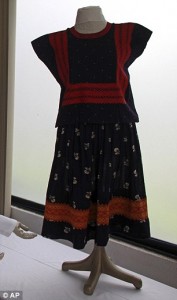 And, we move ahead to the next piece of traditional clothing: The skirt.
And, we move ahead to the next piece of traditional clothing: The skirt.
Now, we should probably set our parameters right from the start: A ‘skirt’ is any piece of clothing that starts somewhere in the vicinity of the waistline and ends somewhere within reach of the knees and the feet. I realize this is a rather broad region, but if we are going to take in everything from a 1960s mini to today’s maxi, that’s what we’ve got to work with. Also, a ‘skirt’ can take in anything as simple as a sarong/lavalava (that is, a piece of fabric that is wrapped around the waist and held up either by itself or some sort of tie) all the way through 18th Century ‘structures’ which require wood, wire, padding, hoops, and probably a birdcage, and probably weighs somewhere in the vicinity of 30-50 pounds. “Skirts’ can include every sort of fabric manipulation known — pleating, gathering, ruching, gores, embroidery, slits, you name it.
Now that we’ve beaten this somewhat to death, we will march on to the subject at hand: skirts as traditional clothing (and I’m afraid you will just have to forgive me for not including ‘men in skirts’ as part of the topic; that will be held aside for another time when we will tackle ‘Mens Non-bifurcated Garments’). The simplest traditional skirt is a sarong, which basically is a piece of fabric wound around the waist or hips and held up with ties at the corners. In tropical climates, this is a universal and non-gendered garment. The next step up would be something like a sari, which requires an underskirt which is tied around the waist and the sari fabric is pleated into the waist of the undergarment. The reason for this is one of those items which seems obvious on its face but is actually the engineering challenge of the skirt: The waist to hip ratio.
From a support standpoint (that is, the ‘how do we keep this thing up?’), skirts hang from the physical feature on the body, either the waist or the hips. If the hips are larger than the waist, when you wind cloth around, you end up with a lot of excess fabric between the waist and the hips and have to figure out what to do with that. If the waist is larger than the hips, and you are wearing the fabric at the waist, then this is not such a big problem. But traditionally (that is, in the far past), skirts were worn at the waist and the engineering solution was first, some sort of belt or tie, followed by a separate waistband and the rest of the skirt fabric was either gathered or pleated into the waistband, which was open at one side and held together (traditionally, before the development of buttons, hooks, or zippers) with ties. The amount of fabric used for the skirt frankly depended on how wealthy the person was (since clothing was traditionally a method of showing status). In some societies (Eastern Europe, for example), the amount of fabric needed in skirts was dictated by another status item: petticoats. The richer you were, the more petticoats you could afford to make or have made for you, embellished with lace and so on, and the longer the skirt had to be to cover them enough so that others could see .. how many petticoats you had and how fancy they were.
In the area where Frida Kahlo’s mother and her family came from (Tehuantepec, in southern Mexico), the skirts consist of a floor-length white petticoat, finished with a deep hem of pleated fabric or pleated lace, topped by a separate and shorter skirt which may or may not be embellished.  As you can see, the skirt on this dressmakers dummy is exactly the same skirt as Frida Kahlo is wearing in the photograph at the top, which is how we know that the white lace at the bottom of the skirt in the top photo is NOT sewn onto the skirt; it is a separate petticoat. How long is this skirt (not the petticoat; the overskirt)? Well, Frida Kahlo, from the information I can find, was 5’2″ tall. Actually, I am the same height and from the waist to the floor, I measure 37″. By ‘eyeball’ measure of the top photo, I’m estimating that the bottom white portion (the petticoat) takes up about 1/3 of the distance between the floor and her waistline, which means that the overskirt, from waist to bottom (without the hem), would be approximately 25″-26″ long (including the waistband). That distance from my waist hits me about mid-calf, so for those folks who want to try to reproduce the look of the top photo, measure your fabric accordingly.
As you can see, the skirt on this dressmakers dummy is exactly the same skirt as Frida Kahlo is wearing in the photograph at the top, which is how we know that the white lace at the bottom of the skirt in the top photo is NOT sewn onto the skirt; it is a separate petticoat. How long is this skirt (not the petticoat; the overskirt)? Well, Frida Kahlo, from the information I can find, was 5’2″ tall. Actually, I am the same height and from the waist to the floor, I measure 37″. By ‘eyeball’ measure of the top photo, I’m estimating that the bottom white portion (the petticoat) takes up about 1/3 of the distance between the floor and her waistline, which means that the overskirt, from waist to bottom (without the hem), would be approximately 25″-26″ long (including the waistband). That distance from my waist hits me about mid-calf, so for those folks who want to try to reproduce the look of the top photo, measure your fabric accordingly.
How wide around is this skirt?Kahlo Book If you look at the photograph on the cover of this study of her wardrobe, the amount of pleating suggests (to me; what do you think?) that the amount of fabric gathered into that waistband is probably twice the length of waistband. In which case, then the amount of fabric you need for this skirt is a measurement that is mid-calf length in one direction and your waist measurement times two in the other direction. Now, this suggests to me that the fabric would have been used cross-ways (that is, the top and bottom of the skirt would have been the selvages so that no piecing would have had to have taken place; there would have been one seam, partially open with the waistband and ties at the top, ending at that seam. So, in terms of the length of fabric you’d need for this skirt, you’d need a length measuring your waist measurement times two.
Or, as an example:
Waist measurement = 30 inches
Length of fabric needed = 30 inches x 2 = 60 inches, which in terms of yardage, equals 1 3/4 yards. As long as your fabric is at least 30 inches wide (which unless we are talking about vintage fabric or Asian silks, is basically a given these days), you’re good to go.
Just a couple of notes: Frida Kahlo did not wear the same sort of skirt all the time. There are self-portraits which she did after her leg was amputated late in her life, when she was basically wheelchair-bound and those skirts are much much fuller, to hide the wheelchair. Second: If what you’d like is NOT a skirt like the one Frida Kahlo is wearing above, but something more along the lines of the sort of skirt that is worn by Mexican dancers, then what you want is a ‘double circle’ skirt and here are directions on how to make one of those: Mexican Folklorico Skirt
